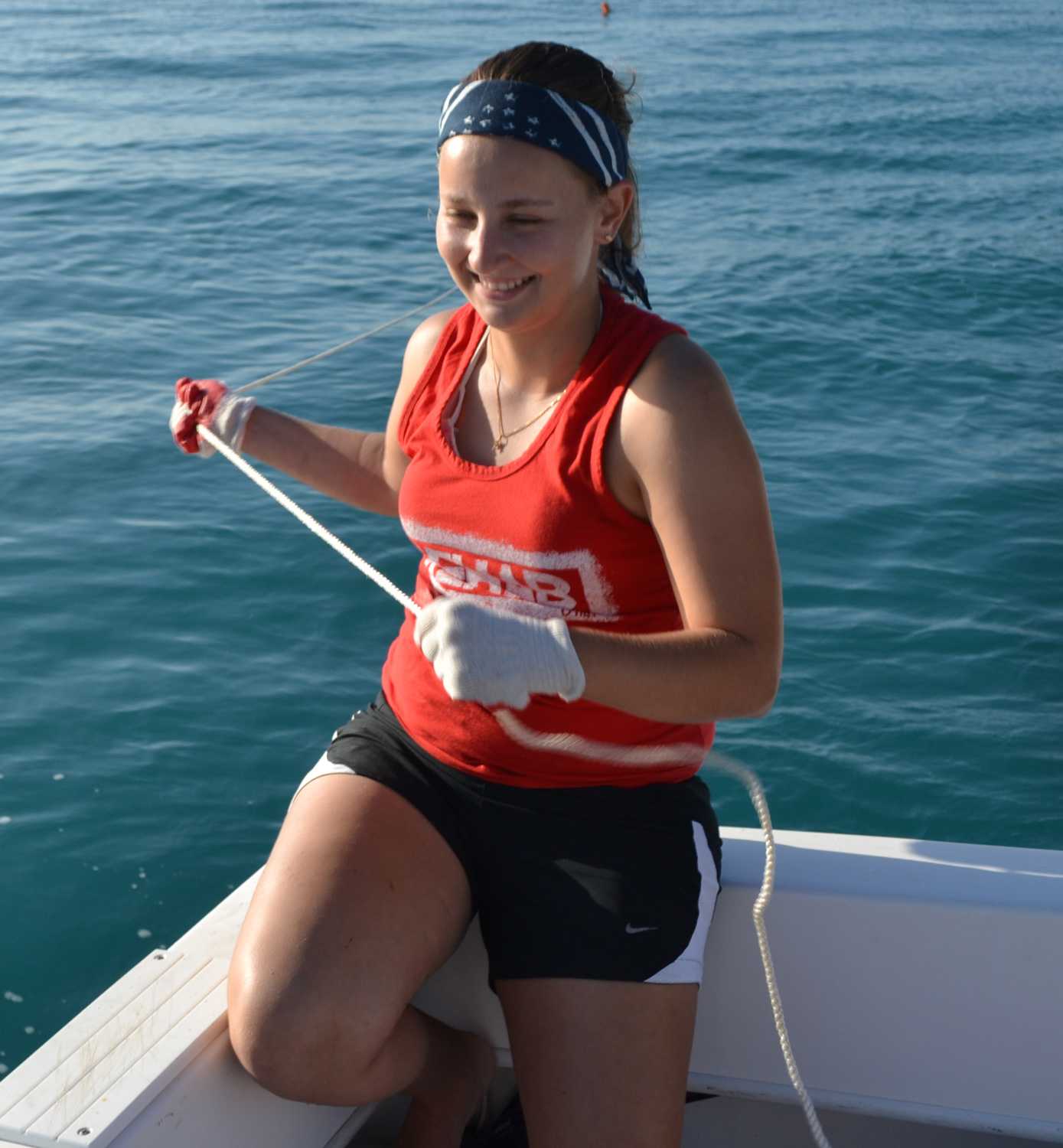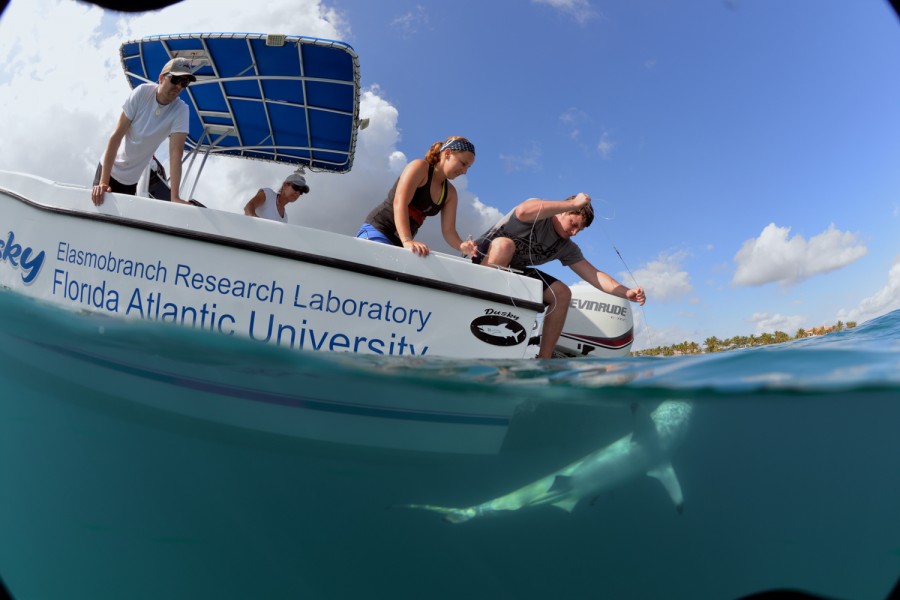Graduate students research shark migration, how sharks perceive world
There are thousands of shark in Palm Beach each winter. One professor and his students study the beasts extensively
Students pull in a black-tip shark on their research boat off of the coast of Palm Beach County in 2015. Photo courtesy of biology professor Stephen Kajiura
February 25, 2015

Correction: In the print version of this article, an error occurred crediting Isaac Newton for a study done with stingrays. It has since been corrected to Kyle Newton.
As FAU biology professor Stephen Kajiura flies over Palm Beach County, he looks to the shore and sees sharks, but not just a couple. There are hundreds of thousands of them up and down the coast migrating to their winter home, a stone’s throw away from the beach.
While that many sharks offshore seems like the plot for a JAWS 4 movie, it is actually a researched reality.
Kajiura’s research on the Boca Raton campus examines this migration. FAU’s location near the ocean is ideal for him and his graduate students to research how sharks perceive the world around them and why so many of them (most of which are black-tips and avoid humans) migrate to Palm Beach County every winter.
In 2011, Kajiura started doing the first systematic survey of this migration by flying over the shore from Boca to Jupiter. He saw hundreds of thousands of sharks close enough to shore that you “could stop your car, throw a stone and hit a shark,” as Kajiura puts it. The Gulf Stream carries the sharks along closer to Palm Beach County than anywhere else on the East Coast.
According to Kajiura, some think it would be good if sharks stayed up north. These opinions are like those about snowbirds, but sharks are top-level predators, they “clean up the sick fish […], alike to spring cleaning,” says Kajiura.
He elaborates that the sharks eat a lot of sick fish, and the lack of their diet
could dramatically hurt the ecosystem around our home. Without the Florida coast’s sharks, our maids of the ocean, the ecosystem could go into a decline, affecting all ocean life in the area and cause student fishers to catch these sickly fish rather than a suitable dinner.
To track the sharks and their numbers, the lab takes advantage of receivers nailed into the seafloor all up and down the East Coast, put there by other research labs to be used by everyone. These receivers pick up signals from small transmitters put into shark abdomens by the graduate students, relaying where the sharks are.
Beth Bowers, one of Kajiura’s graduate students, explains that black-tip sharks actually avoid humans. “When you touch their skin and see them, they don’t seem as scary, just another fish.”
Eloise Cave, another graduate student, thinks differently, “Every time I catch a shark I am always excited […], I’m like a little kid, it’s so cool.”
Studying the black-tips all year long and using the trackers, Kajiura’s lab has found out that black-tip sharks come to Florida in the winter, and go back home to the Georgia area in the summer. As the ocean’s temperature rises, the sharks won’t have to go as far south to stay warm.
The goal of this research, said Kajiura, is to have a baseline comparison for the ecological effect of the oceans warming and to see how this warming could affect the sharks and therefore our own ecosystem. Kajiura says this research is important because the last study was in 1948, and according to Bowers there is “virtually no data on migration.”
Bowers studies the shark’s dumpster diet to get a hint about how they affect the ecosystem. She does so by extracting and examining their stomach contents using a PVC pipe while out on their research boat. As she describes to her friends, she “fishes through their puke” and identifies as much as possible.
Kajiura and his graduate students gather their data on a small research boat, tossing a long line with 60 hooks to catch their bitey subjects, with the students diving as close as 70 feet away from a school of them.
The focus of the research lab is the sensory physiology of sharks, or how they perceive the world around them. One example of a sense sharks have but we don’t is electroreception.
Kajiura says people may ask about their research in electroreception and say, “What’s it good for?” His response is that the biggest threat to sharks is us, and his lab may be close to fixing that.

Imagine being able to tell when a flashlight was turned on or off without seeing it. Kajiura explains that they have an organ called the ampullae of Lorenzini that allows them to sense a small electrical field created by living beings in saltwater.
If humans had this sense, they could play hide-and-seek and be able to find the person even if they were under the floorboards. “Even if [the shark’s prey] is out of sight, smell, or hearing, the shark can find it as long as it is alive and therefore emitting these charges” Kajiura says. The prey would have to be dead for the shark to be incapable of hunting it down.
Most shark deaths are accidental. Fishers catch them regularly without wanting to and kill them to get them off the boat before someone gets hurt. With so many sharks offshore, fishers can easily catch them by accident as well. Kajiura says that since sharks have electroreceptors and other fish don’t, they could make a shark repellant.
Kajiura and his students found that by using zinc and graphite put in saltwater, they could create a small field that would repel sharks. Putting this on the end of a line near the hook, they found that there was an 80 percent reduction in the amount of sharks caught. The FAU graduates and Kajiura have already filed for a patent as well. Kajiura says that it “saves the sharks, but saves the fisherman as well.”
Electricity and magnetism are considered the same force in physics because one can create the other and vice-versa. One of Kajiura’s students, Kyle Newton, decided to test further with their senses and see whether this “sixth sense,” or electroreception, can detect magnetic fields as well.
Kajiura explains that Newton tested this using stingrays who also have this sense, stingrays and sharks both being part of the same class in the animal kingdom called Chondrichthyes. By burying magnets and identical looking non-magnetic control objects and letting the stingray run loose, they found that they can indeed sense magnetic fields by watching it attack everywhere where there were magnets and avoid the identical-looking controls. This is something never before studied, according to Kajiura, and is making history.
As Kajiura mentioned, we need the sharks to help our ecosystem. Hundreds of thousands of sharks, the bulk of which are black-tips, may come off as threatening, but that immediate panic from seeing sharks is something that goes away with exposure as well. “Over time you get used to it” Cave says.







caj • Feb 25, 2015 at 9:16 pm
Really cool research, keep up the innovative studys guys.